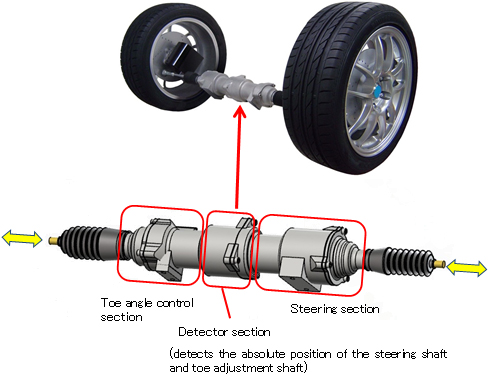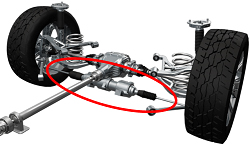
Development of “Rear-wheel Independent Steering System”November 27, 2013
[Better vehicle driving performance with a left-right combined-type steering system and toe control]
NTN Corporation (hereafter, NTN) has developed the “Rear-wheel Independent Steering System” that is capable of toe angle control*1 with a left-right combined-type steering system by applying technology from the steer-by-wire steering system*2*3 to rear wheel steering.
Rear-wheel steering in automobiles is a function to assist vehicle stability at high speeds, as well as improve cornering at low to medium speeds, and is already installed in some luxury-class models. Electric actuators are used to steer the rear wheels, with two main methods available: “left-right combined-type steering” systems that steer both the left and right rear wheels with a single actuator; and “left-right independent” systems with separate actuators for the left and right wheels.
Left-right integrated systems steer either the rear wheels in the same direction, or the opposite direction, as the front wheels, and do not include toe angle correction such as toe-in and toe-out. Left-right independent systems introduce various issues as they increase the unsprung weight of a vehicle*4, which can adversely affect ride comfort and reduce driving performance.
The newly developed “Rear-wheel Independent Steering System” applies technologies acquired during the development of the steer-by-wire steering system, and is capable of toe angle control while consisting of a left-right combined-type steering layout. The actuator is mounted to the vehicle body so there is no increase in the unsprung weight, which means ride comfort is not affected.
NTN is targeting the compact vehicle segment with this system and will market it globally. The system is on show as a reference exhibit at the 43rd Tokyo Motor Show 2013 held at Tokyo Big Sight from November 23.
| *1: | Toe angle control: angle control with the front edge of the tire pointing inwards (toe-in) or outwards (toe-out) with respect to the direction of travel when viewed from above. |
| *2: | Steer-by-wire: Except for the mechanical link mechanism between the steering wheel and the steering gear box, this system changes the steering amount to an electrical signal to drive the wheel-turning actuator according to the amount, and changes the direction of the tires (wheel-turning). |
| *3: | Press release: https://www.ntnglobal.com/en/news/new_products/news201100020.html |
| *4: | Unsprung weight: weight of components around the tires, such as the suspension system including suspension arms, tires, wheels and brakes. |
Features
| (1) | Both rear-wheel steering and toe angle control in a compact unit |
| (2) | Not affected by the unsprung weight of “left-right combined-type steering” systems |
| (3) | Better driving performance with rear-wheel steering control and toe angle control |
Applications
· Automobile rear-wheel steering systems
Inquiries about this release
Product phot
Rear-wheel Independent Steering System

Application of use with rear wheels

Effects of rear-wheel control
| Same Direction | Opposite Direction | Toe-in | Toe Angle 0 | |
|---|---|---|---|---|
| Steering Condition |  |
 |
 |
|
| Effect | Limits yaw that is generated when steering, and increases vehicle stability | Improves cornering | Improves straight-line performance Uneven tire wear |
Improves fuel efficiency Reduces tire wear |
